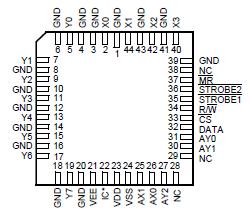MT88V32: Features: • 32 bidirectional CMOS T switches in an 8*4 non-blocking array• Break-before-make switching configuration• Fast setup & hold times for switch programming• 3d...
floor Price/Ceiling Price
- Part Number:
- MT88V32
- Supply Ability:
- 5000
Price Break
- Qty
- 1~5000
- Unit Price
- Negotiable
- Processing time
- 15 Days
SeekIC Buyer Protection PLUS - newly updated for 2013!
- Escrow Protection.
- Guaranteed refunds.
- Secure payments.
- Learn more >>
Month Sales
268 Transactions
Payment Methods
All payment methods are secure and covered by SeekIC Buyer Protection PLUS.

 MT88V32 Data Sheet
MT88V32 Data Sheet







